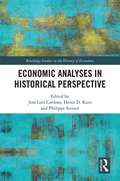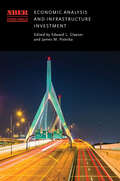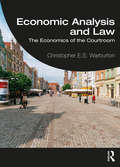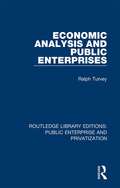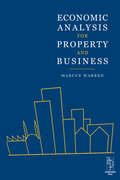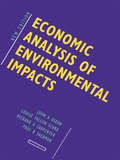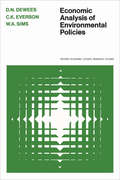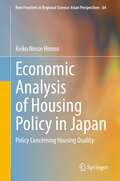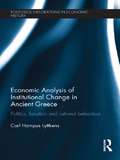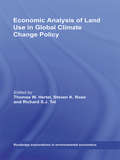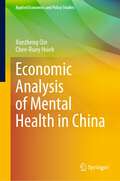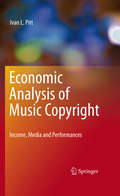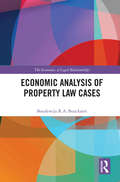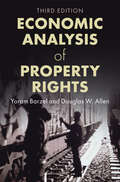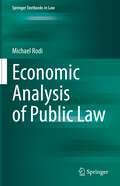- Table View
- List View
Economic Adjustment in Low-Income Countries
by David O. Robinson Susan Schadler Franek Rozwadowski Siddharth Tiwari#Includes bibliographical references (p. ).
Economic Adjustment: Policies and Problems
by Frank HolmesA report from the International Monetary Fund.
Economic Analyses in Historical Perspective (Routledge Studies in the History of Economics)
by José Luís Cardoso Heinz D. Kurz Philippe SteinerThis book brings together leading scholars of the history of economic thought to demonstrate the vitality and richness of a discipline that welcomes both practitioners of intellectual, contextual history, as well as specialists in the historical explanation of the analytical and theoretical dimension of economic science. They shed new light on a variety of themes and problems and move the frontier of knowledge in the areas covered. Economic Analyses in Historical Perspective is presented in three parts. The first deals with French traditions in economics, a field that Gilbert Faccarello has tilled for many years and to which he has made numerous contributions. The second turns to the dissemination and diffusion of economic ideas and theories across national borders, and thus to the European and even global level. Finally, the third part deals with analytical developments in some selected fields of economics: public economics, monetary policy, trade theory and spatial economics. This volume is of great importance to those who study history of economic thought, political economy and monetary economics. The chapters’ centre around the work of Gilbert Faccarello, making this book a fitting tribute to his academic career on the history of economic theory and ideas.
Economic Analysis and Infrastructure Investment (National Bureau of Economic Research Conference Report)
by Edward L. Glaeser and James M. PoterbaPolicy makers often call for increased spending on infrastructure, which can encompass a broad range of investments, from roads and bridges to digital networks that will expand access to high-speed broadband. Some point to the near-term macroeconomic benefits, such as job creation, associated with infrastructure spending; others point to the long-term effects of such spending on productivity and economic growth. Economic Analysis and Infrastructure Investment explores the links between infrastructure investment and economic outcomes, analyzing key economic issues in the funding and management of infrastructure projects. It includes new research on the short-run stimulus effects of infrastructure spending, develops new estimates of the stock of US infrastructure capital, and explores incentive aspects of public-private partnerships with particular attention to their allocation of risk. The volume provides a reference for researchers seeking to study infrastructure issues and for policymakers tasked with determining the appropriate level and allocation of infrastructure spending.
Economic Analysis and Infrastructure Investment (National Bureau of Economic Research Conference Report)
by Edward L. Glaeser and James M. PoterbaPolicy makers often call for increased spending on infrastructure, which can encompass a broad range of investments, from roads and bridges to digital networks that will expand access to high-speed broadband. Some point to the near-term macroeconomic benefits, such as job creation, associated with infrastructure spending; others point to the long-term effects of such spending on productivity and economic growth. Economic Analysis and Infrastructure Investment explores the links between infrastructure investment and economic outcomes, analyzing key economic issues in the funding and management of infrastructure projects. It includes new research on the short-run stimulus effects of infrastructure spending, develops new estimates of the stock of US infrastructure capital, and explores incentive aspects of public-private partnerships with particular attention to their allocation of risk. The volume provides a reference for researchers seeking to study infrastructure issues and for policymakers tasked with determining the appropriate level and allocation of infrastructure spending.
Economic Analysis and Law: The Economics of the Courtroom
by Christopher E.S. WarburtonA comprehensive presentation of the use of economics in judicial decisions, the book is structured to provide all the foundational concepts that are important for the application of economics to the development and interpretation of statutes that emanate from economic conditions. The diversity of the economic field defines the scope of the book and its relevance to the study of law and rule adjudication. Beyond the positive dimensions of law and economics, the book evaluates the normative aspects of law and economics when laws are imprecise, and markets are inefficient. The ethical scope of transactions and rule adjudication are further considered in the context of professional ethics and the rationale for ethical considerations in the practice of law and economics. It presents a unique analysis of law, finance, and economics, by taking a look at the intricate quantitative requirements that are essential for scientific knowledge in the courtroom and the international dimensions of the practice of law and economics beyond municipal frontiers. It alerts entrepreneurs to risk exposures in the global economy and provides foundational information for readers who are also interested in international law and economics, and the essence and interpretations of international conventions appertaining to money, expropriation, the environment, and investments in international financial markets. This book is a useful reference for both undergraduate and graduate students who are interested in law and economics, forensic economics, corporate white-collar crime, and legal studies. It is also valuable for certificate programs for paralegals who wish to have a basic understanding of economic and financial concepts.
Economic Analysis and Multinational Enterprise
by John H. Dunning Professor John DunningWith an impressive array of international contributors from the UK, USA, Sweden and Peru, this book includes chapters on the following: The nature of the multinational enterprise; The theory of the firm; The location of economic activity; Industrial organization; Technology and technological change; the theory of international trade; Monetary policy; The theory of development policy; Wage determination and collective bargaining; Income distribution and welfare considerations and size of firm and size of nation.
Economic Analysis and Public Enterprises (Routledge Library Editions: Public Enterprise and Privatization)
by Ralph TurveyOriginally published in 1971, this is a rigorous analysis of the economic aspects of the efficiency of public enterprises at the time. The author first restates and extends the relevant parts of welfare economics, and then illustrates its application to particular cases, drawing on the work of the National Board for Prices and Incomes, of which he was Deputy Chairman. The analysis is developed stage by stage, with the emphasis on applicability and ease of comprehension, rather than on generality or mathematical elegance. Financial performance, the second-best, the optimal degree of complexity of price structures and problems of optimal quality are first discussed in a static framework. Time is next introduced, leading to a marginal cost concept derived from a multi-period optimizing model. The analysis is then related to urban transport, shipping, gas and coal. This is likely to become a standard work of more general scope than the authors earlier book on electricity supply. It rests, however, on a similar combination of economic theory and high-level experience of the real problems of public enterprises.
Economic Analysis for Property and Business
by Marcus WarrenMarcus Warren's book provides a broad coverage of economic theory, analysis and policy relevant to most undergraduate students studying economics as part of their degree. Specifically it is designed for students studying for property and business related courses and is a vital purchase for all first year students and some second year students involved in these disciplines. It is also relevant for accountancy, business and marketing students studying economics as one or two of their modules. The main feature of this book is the inclusion of an application for students on property surveying courses, building surveying courses and rural land management students as well as some pure business examples for the business students. These applications will cover the main markets for this book at the end of each theory section. The text is clear, concise and includes real life examples and case studies to back up the theory presented. It is global in its appeal, especially relevant for the UK, Europe and the Commonwealth.
Economic Analysis of Environmental Impacts (Environmental And Resource Economics Set Ser.)
by John Dixon Richard Carpenter Paul Sherman Louise ScuraThis revised and updated guide to the environmental economics of development projects demonstrates how the environmental impacts of projects can be translated into monetary values. The theoretical bases are examined, and the techniques themselves given detailed exposition, supported by extensive case studies illustrating a wide range of applications. The text should become a useful complement to all standard forms of project analysis.
Economic Analysis of Environmental Policies
by C. K. Everson Donald Dewees William SimsA framework is concisely presented for the economic analysis of pollution problems and for evaluating proposed solutions. The substantial recent literature on environmental economics is reviewed and related to Ontario environmental policy. Topics include the theory of externalities as an explanation of environmental problems, policy objectives, costs of information and monitoring, and the impact of these costs on control policy selection. Three case studies of specific pollution problems – sulphur dioxide from a smelter, lead from downtown factories, and urban automobile emissions – are given, and possible solutions explored. The authors' methodology is applicable not only to air and water pollution but also to noise, aesthetic degradation, and solid waste. This study will be welcomed by specialists, civil servants, and students trying to understand the economic aspects of environmental maintenance.
Economic Analysis of Environmental Policy
by Ross MckitrickThe relationship between economic growth and the environment is at the forefront of public attention and poses serious challenges for policymakers around the world. Economic Analysis of Environmental Policy, a textbook for advanced undergraduate and graduate courses, provides a rigorous and thorough explanation of modern environmental economics, applying this exposition to contemporary issues and policy analysis.Opening with a discussion of contemporary pollution problems, institutional players and the main policy instruments at our disposal, Ross McKitrick develops core theories of environmental valuation and optimal control of pollution. Chapters that follow cover issues like tradable permits, regulatory standards, emission taxes, and polluter liability as well as advanced topics like trade and the environment, sustainability, risk, inequality, and self-monitoring. Throughout, McKitrick uses clear, intuitive, and coherent analytical tools, so that students, academics, and practitioners can develop their policy analysis skills while comprehending the debates and challenges at the frontier of this exciting and rapidly-developing field.
Economic Analysis of Housing Policy in Japan: Policy Concerning Housing Quality (New Frontiers in Regional Science: Asian Perspectives #64)
by Keiko Nosse HironoThis book analyzes housing policy in terms of the quality of housing, theoretically and empirically. The analysis is prompted by the Japanese government’s success in increasing the volume of housing through interest rate policy, as is shown by Vector Autoregession (VAR) analysis in this book; consequently, the focus of housing policy in Japan is now the quality of housing. This is the first book to analyze and propose housing monetary policy and housing subsidy policy to improve the quality of housing, which increase the number of houses that are barrier-free and earthquake resistant. This book is also the first to focus on appropriate valuation of housing using hedonic price function and the quality of houses. Using the method of valuation developed and proposed in this book, market clearing prices of houses can be calculated without analytical and theoretical error. Toward this end, the disclosure of information – the offer prices and attributes – of houses is proposed as a housing policy. In addition, in this research the author has developed a method to estimate the hedonic price index and rent index using the quality of houses for the first time in Japan. With hedonic price and rent functions, the author shows the extent to which differences in home ownership investment are caused by differences in information about the property. This finding shows the need to explore an appropriate method of valuation of houses. The propositions of this book can help companies benefit from the use of the hedonic housing valuation and hedonic price and rent indexes.
Economic Analysis of Institutional Change in Ancient Greece: Politics, Taxation and Rational Behaviour (Routledge Explorations in Economic History)
by Carl Hampus LyttkensThis book presents an economic analysis of the causes and consequences of institutional change in ancient Athens. Focusing on the period 800-300 BCE, it looks in particular at the development of political institutions and taxation, including a new look at the activities of individuals like Solon, Kleisthenes and Perikles and on the changes in political rules and taxation after the Peloponnesian War.
Economic Analysis of Land Use in Global Climate Change Policy (Routledge Explorations in Environmental Economics)
by Thomas W. Hertel Steven K. Rose Richard S. J. TolLand has long been overlooked in economics. That is now changing. A substantial part of the solution to the climate crisis may lie in growing crops for fuel and using trees for storing carbon. This book investigates the potential of these options to reduce greenhouse gas emissions, estimates the costs to the economy, and analyses the trade-offs with growing food. The first part presents new databases that are necessary to underpin policy-relevant research in the field of climate change while describing and critically assessing the underlying data, the methodologies used, and the first applications. Together, the new data and the extended models allow for a thorough and comprehensive analysis of a land use and climate policy. This book outlines key empirical and analytical issues associated with modelling land use and land use change in the context of global climate change policy. It places special emphasis on the economy-wide competition for land and other resources, especially; The implications of changes in land use for the cost of climate change mitigation, Land use change as a result of mitigation, and Feedback from changes in the global climate to land use. By offering synthesis and evaluation of a variety of different approaches to this challenging field of research, this book will serve as a key reference for future work in the economic analysis of land use and climate change policy.
Economic Analysis of Mental Health in China (Applied Economics and Policy Studies)
by Chee-Ruey Hsieh Xuezheng QinThis book uses an economic approach to analyze the socioeconomic causes and consequences of mental health disorders in China, with a special focus on mental depression. Based on a nationally representative dataset, we first investigate the prevalence and distribution of depression and depressive symptoms among China’s adult population, and then use several econometric methods to estimate the multi-dimensional disease burden of the mental disorder, such as its direct medical costs, its indirect economic costs, and its hidden costs on social trust and life satisfaction. In addition, we specifically address the socioeconomic determinants of mental health by examining how the relative and absolute economic status may determine people’s mental depression. Lastly, we propose an analytical framework to evaluate the four major hurdles that cause the treatment gaps of mental health care, and discuss the policy options to overcome such hurdles and to address the unmet mental healthcare needs in China and other developing countries. The book may facilitate our understanding on the complex determinants and implications of the rising prevalence of mental health disorders in developing countries like China. In addition to the students, teachers, and researchers in the fields of health economics and public health, the book may also be of interest to health policy makers and non-government agencies who are concerned with addressing the global mental healthcare challenges using economic policy tools.
Economic Analysis of Music Copyright
by Ivan L. PittChris Anderson's initial `Long Tail' analysis was released in 2004 just as the wave of mergers and acquisitions was sweeping the music publishing and radio industries. Music industry executives began looking for Anderson's 'Long Tail' effect and with it the implied redistribution of royalty income from popular songs to long dormant and forgotten works in their catalogs. These music publishers had hoped to further maximize the value of their copyright assets (lyrics and melody) in their existing music catalogs as the sale of compact disks diminished, and consumers switched their purchasing and listening habits to new digital formats in music technology such as the iPod. This book deals with the measurement of skewness, heavy tails and asymmetry in performance royalty income data in the music industry, an area that has received very little academic attention for various reasons. For example, the pay packages, including signing bonuses, of some `superstars' in the sports world are often announced when they join a team. In the art world, the value of an artist's work is sometimes revealed when the work is sold at auction. The main reason it is difficult to study art and culture from a royalty income perspective is that most of the income data at the individual level is often proprietary, and generally not made publicly available for economic analysis. As a Senior Economist for the American Society of Composers, Authors, and Publishers (ASCAP) using both internal and licensed external proprietary data, the author found that the so-called `superstar effects' are still present in performance royalty income. Success is still concentrated on a relatively few copyright holders or members who can be grouped into `heavy tails' of the empirical income distribution in a departure from Anderson's `long tail' analysis. This book is divided into two parts. The first part is a general introduction to the many supply and demand economic factors that are related to music performance royalty payments. The second part is an applied econometrics section that provides modeling and in-depth analysis of income data from a songwriter, music publisher and blanket licensing perspective. In an era of declining income from CD album sales, data collection, mining and analysis are becoming increasingly important in terms of understanding the listening, buying and music use habits of consumers. The economic impact on songwriters, publishers, music listeners, and Performance Rights Organizations (PROs) is discussed and future business models are evaluated. The book will appeal to researchers and students in cultural economics, media and statistics as well as general readers and professionals in the music publishing industry.
Economic Analysis of Property Law Cases: A Casebook (The Economics of Legal Relationships)
by Boudewijn R. BouckaertThe discipline of law and economics has earned a reputation for developing plausible and empirically testable theories on the social functions and the impact of legal institutions. Property rights are a field in which this has been very successful. In this book, economic property rights theories are applied to case law in order to examine the practice and solution of real life conflicts. The author examines the economic problems which are dealt with in these cases and evaluate the courts’ decisions from an economic angle. Cases are examined from across the UK, the US, Germany, Belgium and Canada to allow international comparisons to be made. These comparisons reveal that, regardless of the legal system, many legal issues have similar economic roots and therefore similar models of economic analysis can be applied. The analysis of these cases also shows that the discipline of law and economics is not only successful in developing explanatory models but also useful to generate better considerations and solutions for legal conflicts in individual cases. This book aims to bridge the gap between the academic and professional literature and demonstrate the benefits of the economic analysis of property rights cases to all those who are interested in law and economics.
Economic Analysis of Property Rights (Political Economy of Institutions and Decisions)
by Douglas W. Allen Yoram BarzelThe standard neoclassical model of economics is incapable of explaining why one form of organization arises over another. It is a model where transaction costs are implicitly assumed to not exist; however, transaction costs are here defined as the costs of strengthening a given distribution of economic property rights, and they always exist. Economic Analysis of Property Rights is a study of how individuals organise resources to maximise the value of their economic rights over these resources. It offers a unified theoretical structure to deal with exchange, rights formation, and organisation that traditional economic theory often ignores. It explains how transaction costs can be reduced through reorganization and, in the end, how the distribution of property rights that exists is the one that maximizes wealth net of these transaction costs. This necessary hypothesis explains much of the puzzling organizations and institutions that exist now and have existed in the past.
Economic Analysis of Provincial Land Use Policies in Ontario
by Mark W. Frankena David T. ScheffmanThis book describes and analyses the provincial government's role in municipal and regional planning. The conversion of farmland to urban and other uses is discussed, as are the issues raised by the reports of the Ontario Planning Act Review Committee and the Federal/Provincial Task Force on the Supply and Price of Serviced Residential Land and the province's Green Paper on Planning for Agriculture. The authors criticize the government's failure to conduct cost-benefit studies before setting up planning programs and show that there is little factual basis for recent alarm over the disappearance of farmland. Data gathered here for the first time show that the conversion of agricultural land to built-up urban use and non-farm rural residential use in Ontario has been taking place quite slowly in view of the rate of productivity increase in agriculture, the stock of agricultural land, and the decline in the acreage of census farms. Economists will find in this book a useful survey of recent trends and policies. Planners, policy-makers, and students will welcome this detailed case study of how economic analysis ought to be used in formulating land use policies.
Economic Analysis of Public Law (Springer Textbooks in Law)
by Michael RodiThis textbook analyses from an economic perspective the phenomena of public law, the constitution, the democratic and political process, federalism, NGOs, administration and state decisions. It also examines selected fields of administrative law, including finance and tax law, public economic law and environmental law. Although the book uses examples from different legal orders, it maintains a focus on continental European law, as it aims to advance the law and economics approach in Europe.
Economic Analysis of the Digital Economy (National Bureau of Economic Research Conference Report)
by Avi Goldfarb, Shane M. Greenstein, and Catherine E. TuckerAs the cost of storing, sharing, and analyzing data has decreased, economic activity has become increasingly digital. But while the effects of digital technology and improved digital communication have been explored in a variety of contexts, the impact on economic activity—from consumer and entrepreneurial behavior to the ways in which governments determine policy—is less well understood. Economic Analysis of the Digital Economy explores the economic impact of digitization, with each chapter identifying a promising new area of research. The Internet is one of the key drivers of growth in digital communication, and the first set of chapters discusses basic supply-and-demand factors related to access. Later chapters discuss new opportunities and challenges created by digital technology and describe some of the most pressing policy issues. As digital technologies continue to gain in momentum and importance, it has become clear that digitization has features that do not fit well into traditional economic models. This suggests a need for a better understanding of the impact of digital technology on economic activity, and Economic Analysis of the Digital Economy brings together leading scholars to explore this emerging area of research.
Economic Analysis of the Environmental Impacts of Development Projects (Environmental and Resource Economics Set)
by John A. Dixon Richard A. Carpenter Louise A. Fallon Paul B. Sherman Supachit ManipomokeIt has always been thought that some level of pollution and waste is unavoidable in development projects. But no one has made much effort to quantify and assess the extent of this sort of damage. In this book a group of analysts from the Asian Development Bank and from the East West Center propose a means of constructing useful economic evaluations of the impacts of development projects on the environments in which they are constructed. This study demands the systematic evaluation of all the intentional and unintentional consequences of development initiatives before they are determined upon. It is essential reading for development economists, analysts and bankers. Originally published in 1986
Economic Analysis, Moral Philosophy, and Public Policy
by Debra Satz Michael Mcpherson Daniel HausmanThis book shows through argument and numerous policy-related examples how understanding moral philosophy can improve economic analysis, how moral philosophy can benefit from economists' analytical tools, and how economic analysis and moral philosophy together can inform public policy. Part I explores the idea of rationality and its connections to ethics, arguing that when they defend their formal model of rationality, most economists implicitly espouse contestable moral principles. Part II addresses the nature and measurement of welfare, utilitarianism and cost-benefit analysis. Part III discusses freedom, rights, equality, and justice - moral notions that are relevant to evaluating policies, but which have played little if any role in conventional welfare economics. Finally, Part IV explores work in social choice theory and game theory that is relevant to moral decision making. Each chapter includes recommended reading and discussion questions.
Economic Analysis, Moral Philosophy, and Public Policy
by Michael S. Mcpherson Daniel M. HausmanThis 2006 book shows through accessible argument and numerous examples how understanding moral philosophy can improve economic analysis, how moral philosophy can benefit from economists' analytical tools, and how economic analysis and moral philosophy together can inform public policy. Part I explores rationality and its connections to morality. It argues that in defending their model of rationality, mainstream economists implicitly espouse contestable moral principles. Part II concerns welfare, utilitarianism and standard welfare economics, while Part III considers important moral notions that are left out of standard welfare economics, such as freedom, rights, equality, and justice. Part III also emphasizes the variety of moral considerations that are relevant to evaluating policies. Part IV then introduces technical work in social choice theory and game theory that is guided by ethical concepts and relevant to moral theorizing. Chapters include recommended readings and the book includes a glossary of relevant terms.


